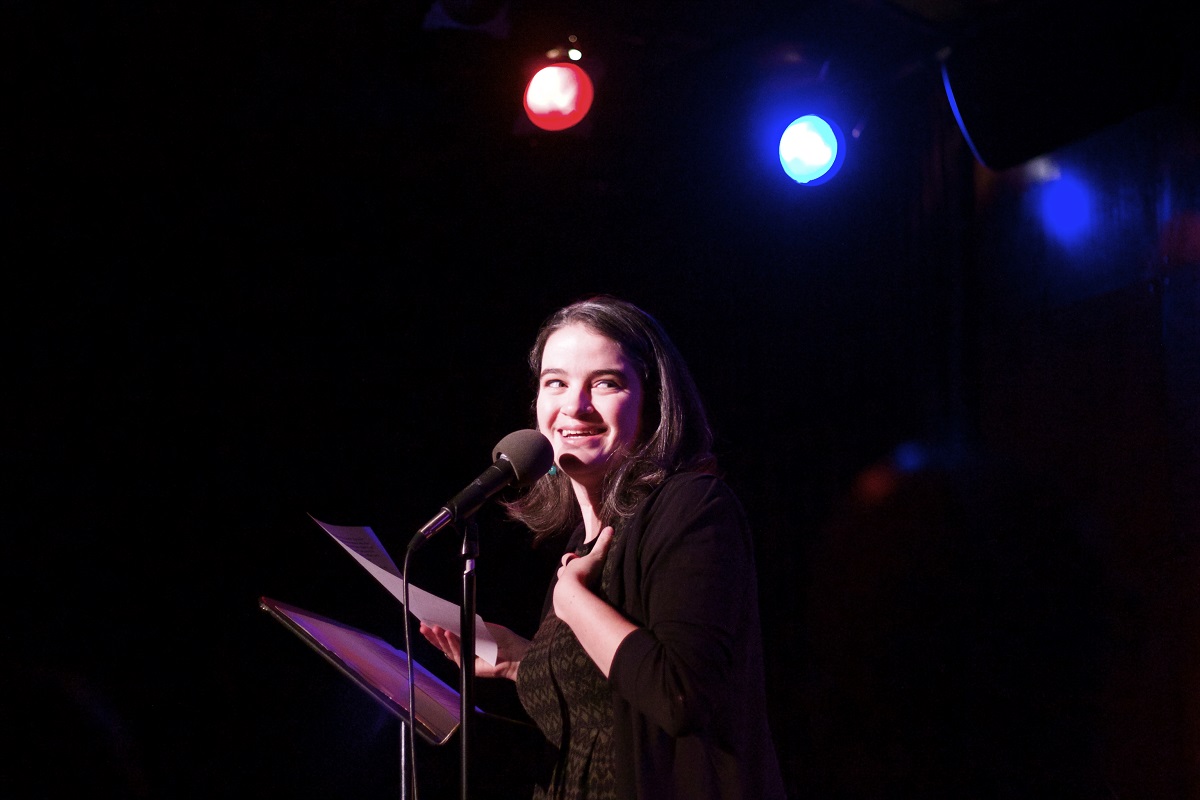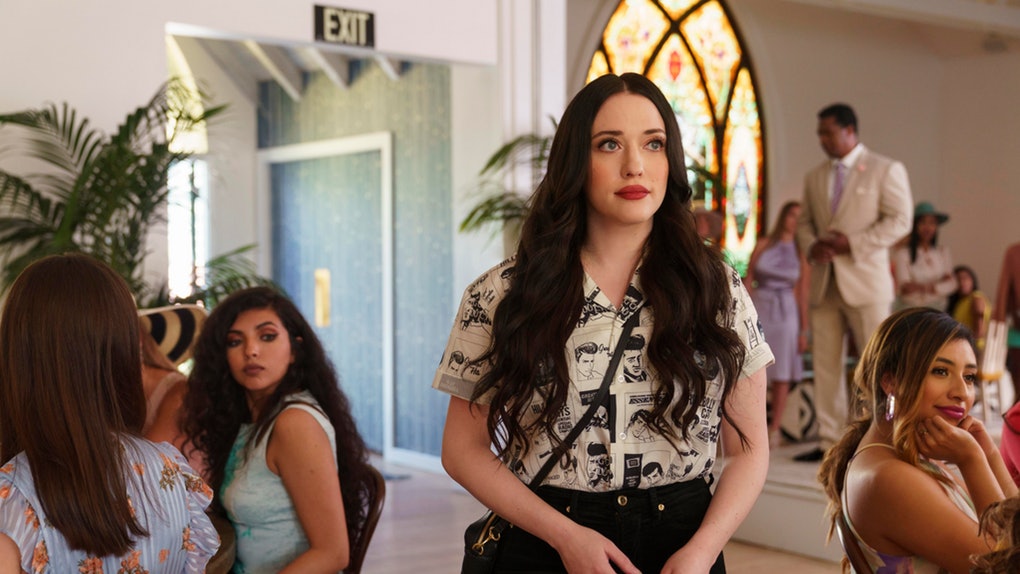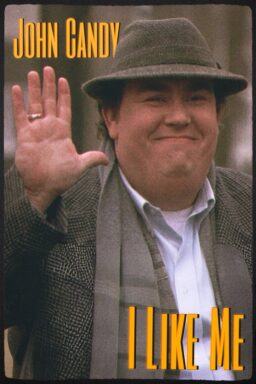I’ll say this for Hulu’s “Dollface,” the new comedy series from first-time showrunner Jordan Weiss and star and executive producer Kat Dennings: It doesn’t shy away from the big swings. A half-hour single-cam comedy that begins with protagonist Jules (Dennings) getting surprise-dumped while sharing a meal with her unexceptional boyfriend of five years, the series works in a woman with the head of a cat driving a bus full of weeping recent dumpees within minutes. Over the course of the season, it sees Jules join a fantasy newscast about the impending disaster of running into her ex in public, places her in a multi-cam world to underline her sitcom status as the boring friend, asks her to play a retro game show to determine whether or not she’ll attend a friend’s party, and shoves her into Dorothy Gale drag for an episode-length “Wizard Of Oz” riff about the meaning of feminism (spoiler: It can’t be defined, apparently). Through it all, that cat-headed woman keeps showing up—because she’s a cat lady, get it?
The willingness to take risks and experiment with the ways Jules’ story can be told is, without a doubt, the best thing about “Dollface,” an at-best amusing, at-worst infuriating comedy that misses far more than it hits. And honestly, it really is worth applauding. But if that Cat Lady epitomizes the show’s willingness to get weird, she also symbolizes its three greatest shortcomings. First, it’s just not as clever or incisive as it thinks it is, jumping into weary stereotypes with zeal and enthusiasm but not much thought, as though including them alone is somehow subversive. (She got dumped, so now she’s talking to a lady who is a cat, like an actual cat lady? See? Cat? Lady? Cat lady?) Second, it’s not at all clear what she has to do with anything; the world of the show is adventurous, sure, but also simultaneously shallow and emotionally opaque, with no clear indication of the rules or logic of this reality and little to suggest why these people are important to each other, or why they should matter to us. And third, it squanders some serious talent by hiding spark behind layers of artifice, because reader, I regret to inform you that the voice of that animated Cat Lady head belongs to Beth Grant, a world-class character actor here given basically nothing to do but shriek and attempt to land doomed punchlines.
Beth Grant. Beth Grant. Beth Grant is credited in all 10 of the episodes of this first season, but she has more to do in the few minutes of screentime she has in “Speed” than she does in these five hours—and a big part of her job in “Speed” was shrieking, too. This is not a slight against “Speed.” “Speed” is great, and Beth Grant is marvelous in it, as she is in nearly everything. But Helen the hysterical bus passenger has roughly 200 percent more shading and story relevance than the recurring fantasy Cat Lady, who comes across as nothing so much as an idea that got tossed out in a pitch meeting that everyone involved was then terrified to cut.

I want to address both the wasted talent and the bewildering logic of the show, but it’s worth first laying out a little bit more of what exactly this series is about. As Jules, Dennings plays a woman who essentially ditched all her female friends when she met Jeremy (Connor Hines, intentionally insufferable in a way that’s unintentionally insufferable). After he ditches her at the Cat Lady’s bus stop, she’s forced to attempt to rebuild the relationships she abandoned, notably with Madison (Brenda Song of “The Social Network”) and Stella (“You” standout Shay Mitchell); she also makes friends with an extremely quirky coworker (“Crazy Ex-Girlfriend” alum Esther Povitsky) at the women’s wellness/empowerment/media/platitude company run by a wasted Malin Ackerman. It is called “Woom,” and they make anus crystals. Jules repairs these relationships by existing in the plot; it’s all flimsy story as excuse for punchline or set-piece, but with an emotional soundtrack layered underneath to make sure we know this is about capital-F Female Friendship. Imagine a half-hour “Saturday Night Live” sketch about some female stereotype suddenly got a “Grey’s Anatomy”-style musical montage at the end, and you’ve got “Dollface.”
“Saturday Night Live” sketches are sometimes funny, and so is this series; that’s part of what makes the experience so frustrating. Dennings has proven herself capable of rising above lackluster material on several occasions—she’s a highlight in the first two “Thor” films, as one example—but “Dollface” wedges her somewhere between endearing smartass and emotionally stunted 30-something without ever allowing her to really be either. She’s got the odd great moment, but mostly the madness just revolves around her. Song, Mitchell, and Povitsky all fare better, and could probably be great in the version of the show they’re giving us; Song is in a straightforward sitcom, Mitchell in a grounded dramedy with heightened language, and Povitsky is basically playing a hybrid from her characters in “Crazy Ex-Girlfriend” and “Alone Together,” both better shows with specific points of view. They are endearing, wildly charismatic, and very funny respectively, and it all adds up to very little. But the lament for the talent wasted here extends to the show’s writers, Weiss included—every so often you encounter a flash of what this show could be, usually in the form of a biting one-liner or one of those wild swings, and it makes the hollowness of it all that much less acceptable.
Conceptually, it’s all big but empty, stating and restating its points with gleeful self-satisfaction but without bothering to really explore. Its characters are all traits and no truth, and as such, Jules and company bop around aimlessly to whatever “life as a girl, am I right?” scenario that’s up next without ever making choices that feel recognizably human. Even the basic details feel off, as though created by some sort of automated scenario generator: Jules rents a fully furnished “old lady apartment” that’s painstakingly art-directed but somehow devoid of personality, old or otherwise; a spat between friends pits bloody marys against mimosas, centered on the belief that free spirits drink bloody marys and rich, together people drink mimosas, because they’re made with champagne. (If someone is making you mimosas with real champagne, they are wasting their champagne.) And the all-important friendships simply exist—a state that wouldn’t be such a problem if the show were interested in exploring whether or not these people should be friends, which it is not.
That last point ties into the most damning of “Dollface”‘s stumbles: Those women don’t even really seem to like each other, let alone love each other, and “Dollface” doesn’t seem to love them, either. “I think I’m definitely feminish,” Jules says at one point, and if it could speak (perhaps in the voice of a Cat Lady), the show would probably say the same. It claims, in a late-arriving episode, that feminism can’t be defined; one assumes the point it’s trying to make is that it’s not one-size-fits-all. But disdain for women isn’t feminish, internalized misogyny isn’t funny, and reducing your central characters to sketches without allowing them to be more at the same time isn’t a good way to make TV, feminist or otherwise. This is a great cast of women, trapped in a series made by a bunch of obviously talented people who will almost certainly go on to make smart, funny, daring, bold things. This isn’t one of them. Dump it at the Cat Lady bus station and be on your way.
Eight episodes screened for review.












